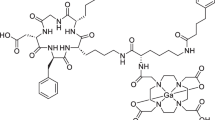Abstract
Objective
NMK36 is a novel PET tracer containing a synthetic amino acid analogue anti-[18F]FACBC as the active ingredient, and is under development for the use of tumor diagnosis. A Phase I clinical study of NMK36 was conducted to evaluate its safety, biodistribution, and radiation dosimetry in healthy volunteers.
Methods
Six healthy volunteers (Japanese male) received a bolus injection of NMK36 (174.4–201.4 MBq) intravenously. The safety of NMK36 was evaluated by monitoring signs/symptoms, electrocardiography, recording vital signs, and laboratory examinations at baseline and several time points in 6 days after injection. A total of 11 whole-body PET-CT scans were acquired up to 4 h post-injection, and venous blood and urine samples were also collected for 6 and 24 h post-injection, respectively. Based on the results of the biodistribution study, absorbed radiation dose was estimated by the MIRD method.
Results
Although two adverse events occurred after the injection of NMK36, they were mild and disappeared without any specific treatment. NMK36 preferentially accumulated in the pancreas and liver early after injection, followed by rapid clearance from the pancreas. Persistent uptake was observed in the skeletal muscle. NMK36 showed low uptake in the brain, and its urinary excretion was limited (5.40 ± 1.43% of the injected dose at 24 h post-injection). The liver was the critical organ, with a mean absorbed dose of 40.6 μGy/MBq. The estimated effective dose of NMK36 was 13.8 μSv/MBq, which was similar to or lower than those of radiotracers approved for clinical use including [18F]FDG.
Conclusions
The findings of this study indicate that NMK36 is well tolerated. NMK36 has favorable characteristics for imaging brain and pelvic tumors, such as low brain uptake, slow urinary excretion, and high in vivo stability.




Similar content being viewed by others
References
Kosuda S, Kison PV, Greenough R, Grossman HB, Wahl RL. Preliminary assessment of fluorine-18 fluorodeoxyglucose positron emission tomography in patients with bladder cancer. Eur J Nucl Med. 1997;24:615–20.
Shreve PD, Grossman HB, Gross MD, Wahl RL. Metastatic prostate cancer: initial findings of PET with 2-deoxy-2-[F-18]fluoro-d-glucose. Radiology. 1996;199:751–6.
Engel H, Steinert H, Buck A, Berthold T, Huch Böni RA, von Schulthess GK. Whole-body PET: physiological and artifactual fluorodeoxyglucose accumulations. J Nucl Med. 1996;37:441–6.
Oka S, Hattori R, Kurosaki F, Toyama M, Williams LA, Yu W, et al. A preliminary study of anti-1-amino-3-18F-fluorocyclobutyl-1-carboxylic acid for the detection of prostate cancer. J NucI Med. 2007;48:46–55.
Shoup TM, Goodman MM. Synthesis of [F-18]-1-amino-3-fluorocyclobutane-1-carboxylic acid (FACBC): a PET tracer for tumor delineation. J Label Comp Radiopharm. 1999;42:215–25.
Shoup TM, Olson J, Hoffman JM, Vote J, Eshima D, Shim L, et al. Synthesis and evaluation of [18F] 1-amino-3-fluorocyclobutane-1-carboxylic acid to image brain tumors. J NucI Med. 1999;40:331–8.
Schuster DM, Votaw JR, Nieh PT, Yu W, Nye JA, Master V, et al. Initial experience with the radiotracer anti-1-amino-3-18F-fluorocyclobutane-1-carboxylic acid with PET/CT in prostate carcinoma. J Nucl Med. 2007;48:56–63.
Nye JA, Schuster DM, Yu W, Camp VM, Goodman MM, Votaw JR. Biodistribution and radiation dosimetry of the synthetic nonmetabolized amino acid analogue anti-18F-FACBC in humans. J Nucl Med. 2007;48:1017–20.
Michael G, Richard B, Eric C. OLINDA/EXM: the second-generation personal computer software for internal dose assessment in nuclear medicine. J Nucl Med. 2005;46:1023–7.
Tanaka G. Japanese reference man 1988—III. Masses of organs and tissues and other physical properties. Nippon Igaku Hoshasen Gakkai Zasshi. 1988 Apr 25;48:509–13 (in Japanese).
Cloutier R, Smith S, Watson E, Snyder W, Warner G. Dose to the fetus from radionuclides in the bladder. Health Phys. 1973;25:147–61.
Deloar HM, Fujikawa T, Nakamura T, Itoh M, Imai D, Miyake M, et al. Estimation of internal absorbed dose of l-[methyl-11C]methionine using whole- body positron emission tomography. Eur J Nucl Med. 1998;25:629–33.
Pauleit D, Floeth F, Herzog H, Hamacher K, Tellmann L, Müller HW, et al. Whole-body distribution and dosimetry of O-(2-[18F]fluoroethyl)-l-tyrosine. Eur J Nucl Med Mol Imaging. 2003;30:519–24.
ICRP. Annals of the ICRP, Publication 80. Oxford: Pergamon; 1998.
ICRP. Annals of the ICRP, Publication 62. Oxford: Pergamon Press; 1991.
Author information
Authors and Affiliations
Corresponding author
Rights and permissions
About this article
Cite this article
Asano, Y., Inoue, Y., Ikeda, Y. et al. Phase I clinical study of NMK36: a new PET tracer with the synthetic amino acid analogue anti-[18F]FACBC. Ann Nucl Med 25, 414–418 (2011). https://doi.org/10.1007/s12149-011-0477-z
Received:
Accepted:
Published:
Issue Date:
DOI: https://doi.org/10.1007/s12149-011-0477-z




